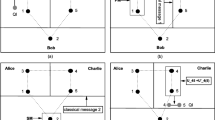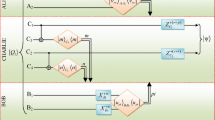Abstract
Experimental free-will or measurement independence is one of the crucial assumptions in derivation of any nonlocal theorem. Any nonlocal correlation obtained in quantum world can have a local deterministic explanation if there is no experimental free-will in choosing the measurement settings. Recently, Hall (Phys Rev Lett 105:250404, 2010) has shown that to obtain a local deterministic description for singlet state correlation one does not need to give up measurement independence completely, but a partial measurement dependence suffices. In three party scenario considering Greenberger–Horne–Zeilinger (GHZ) correlation one can exhibit absolute contradiction between quantum theory and local realism. In this paper we show that such correlation also has local deterministic description if measurement independence is given up, even if not completely. We provide a local deterministic model for equatorial Von Neumann measurements on tripartite GHZ state by sacrificing measurement independence partially.

Similar content being viewed by others
Explore related subjects
Discover the latest articles and news from researchers in related subjects, suggested using machine learning.References
Einstein, A., Podolsky, B., Rosen, N.: Can quantum-mechanical description of physical reality be considered complete? Phys. Rev. 47, 777–780 (1935). doi:10.1103/PhysRev.47.777
Bell, J.S.: On the Einstein–Podolsky–Rosen paradox. Physics 1(3), 195–200 (1964)
Bell, J.S.: Speakable and Unspeakable in Quantum Mechanics. Cambridge University Press, Cambridge (2004)
Aspect, A., Grangier, P., Roger, G.: Experimental realization of Einstein–Podolsky–Rosen–Bohm Gedanken experiment: a new violation of Bell’s inequalities. Phys. Rev. Lett. 49, 91–94 (1982). doi:10.1103/PhysRevLett.49.91
Aspect, A., Dalibard, J., Roger, G.: Experimental test of Bell’s inequalities using time-varying analyzers. Phys. Rev. Lett. 49, 1804–1807 (1982). doi:10.1103/PhysRevLett.49.1804
Aspect, A.: Bell’s inequality test: more ideal than ever. Nat. (Lond.) 398, 189–190 (1999). http://www.nature.com/nature/journal/v398/n6724/full/398189a0.html
Greenberger, D.M., Horne, M.A., Zeilinger, A.: Bell’s theorem without inequalities. Am. J. Phys. 58(12), 1131–1143 (1990). http://www.physik.uni-bielefeld.de/yorks/qm12/ghsz.pdf
Pan, J.W., Bouwmeester, D., Daniell, M., Weinfurter, H., Zeilinger, A.: Experimental test of quantum nonlocality in three-photon GreenbergerHorneZeilinger entanglement. Nature 403, 515–519 (2000). http://www.nature.com/nature/journal/v403/n6769/abs/403515a0.html
Brunner, N., Cavalcanti, D., Pironio, S., Scarani, V., Wehner, S.: Bell nonlocality. Rev. Mod. Phys. 86, 419 (2014). doi:10.1103/RevModPhys.86.419
Barrett, J., Hardy, L., Kent, A.: No signaling and quantum key distribution. Phys. Rev. Lett. 95, 010503 (2005). doi:10.1103/PhysRevLett.95.010503
Acín, A., Brunner, N., Gisin, N., Massar, S., Pironio, S., Scarani, V.: Device-independent security of quantum cryptography against collective attacks. Phys. Rev. Lett. 98, 230501 (2007). doi:10.1103/PhysRevLett.98.230501
Pironio, S., Acín, A, Brunner, N., Gisin, N., Massar, S., Scarani, V.: Device-independent quantum key distribution secure against collective attacks. New J. Phys. 11, 045021 (2009). http://iopscience.iop.org/1367-2630/11/4/045021
Vazirani, U., Vidick, T.: Fully device independent quantum key distribution. arXiv:1210.1810
Colbeck, R., Kent, A.: Private randomness expansion with untrusted devices. J. Phys. A 44, 095305 (2011). doi:10.1088/1751-8113/44/9/095305
Pironio, S., et al.: Random numbers certified by Bells theorem. Nat. (Lond.) 464, 1021–1024 (2010). http://www.nature.com/nature/journal/v464/n7291/full/nature09008.html
Banik, M.: Measurement-device-independent randomness certification by local entangled states. arXiv:1401.1338
Maudlin, T.: In: Hull, D., Forbes, M., Okruhlik, K. (eds.) Proceedings of the 1992 Meeting of the Philosophy of Science Association, vol. 1, pp. 404–417 (Philosophy of Science Association, East Lansing, MI) (1992)
Brassard, G., Cleve, R., Tapp, A.: Cost of exactly simulating quantum entanglement with classical communication. Phys. Rev. Lett. 83, 1874–1877 (1999). doi:10.1103/PhysRevLett.83.1874
Steiner, M.: Towards quantifying non-local information transfer: finite-bit non-locality. Phys. Lett. A 270, 239244 (2000). doi:10.1016/S0375-9601(00)00315-7
Toner, B.F., Bacon, D.: Communication cost of simulating Bell correlations. Phys. Rev. Lett. 91, 187904 (2003). doi:10.1103/PhysRevLett.91.187904
Tessier, T.E., Caves, C.M., Deutsch, I.H., Eastin, B.: Optimal classical-communication-assisted local model of n-qubit Greenberger–Horne–Zeilinger correlations. Phys. Rev. A 72, 032205 (2005). doi:10.1103/PhysRevA.72.032305
Broadbent, A., Chouha, P.R., Tapp, A.: In: Proceedings of the Third International Conference on Quantum, Nano and Micro Technologies (ICQNM 2009)
Branciard, C., Gisin, N.: Quantifying the nonlocality of Greenberger–Horne–Zeilinger quantum correlations by a bounded communication simulation protocol. Phys. Rev. Lett. 107, 020401 (2011). doi:10.1103/PhysRevLett.107.020401
Brassard, G., Devroye, L., Gravel, C.: Exact simulation for the GHZ distribution. arXiv:1303.5942 (2013)
Shimony, A., Horne, M.A., Clauser, J.F.: An exchange on local beables. Dialectica 39, 97–102 (1985)
Hall, M.J.W.: Local deterministic model of singlet state correlations based on relaxing measurement independence. Phys. Rev. Lett. 105, 250404 (2010). doi:10.1103/PhysRevLett.105.250404
Hall, M.J.W.: Relaxed Bell inequalities and Kochen–Specker theorems. Phys. Rev. A 84, 022102 (2011). doi:10.1103/PhysRevA.84.022102
Barrett, J., Gisin, N.: How much measurement independence is needed to demonstrate nonlocality? Phys. Rev. Lett. 106, 100406 (2011). doi:10.1103/PhysRevLett.106.100406
Brans, C.H.: Bell’s theorem does not eliminate fully causal hidden variables. Int. J. Theor. Phys. 27(2), 219–226 (1988). doi:10.1007/BF00670750
Mermin, N.D.: Extreme quantum entanglement in a superposition of macroscopically distinct states. Phys. Rev. Lett. 65, 1990 (1838). doi:10.1103/PhysRevLett.65.1838
Hillery, M., Bužek, V., Berthiaume, A.: Quantum secret sharing. Phys. Rev. A 59, 1999 (1829). doi:10.1103/PhysRevA.59.1829
Zhao-Yang, T., Le-Man, K.: Broadcasting of entanglement in three-particle Greenberger–Horne–Zeilinger state via quantum copying. Chin. Phys. Lett. 17(7), 469–471 (2000). http://cpl.iphy.ac.cn/EN/Y2000/V17/I7/469
Jin, X.-R., et al.: Three-party quantum secure direct communication based on GHZ states. Phys. Lett. A 354(1–2), 67–70 (2006). doi:10.1016/j.physleta.2006.01.035
Banik, M., Gazi, M.D.R., Das, S., Rai, A., Kunkri, S.: Optimal free will on one side in reproducing the singlet correlation. J. Phys. A Math. Theor. 45, 205301 (2012). doi:10.1088/1751-8113/45/20/205301
Acknowledgments
It is a pleasure to thank Guruprasad Kar for many stimulating discussions. MB acknowledge C. Branciard for fruitful discussions. AM acknowledges support from CSIR, Govt. of India (File No.09/093(0148)/ 2012-EMR-I).
Author information
Authors and Affiliations
Corresponding author
Appendices
Appendix 1: Calculation of measurement dependency
The degree of measurement dependency is quantified as Eq. (8). To find \(M\) we have to maximize the difference between the densities of hidden variable (HV) for all pairs of measurement settings over the HV space. The difference will be maximized if the upper value of the distribution of HV corresponding to one measurement setting overlaps by maximum amount with the lower value of the other measurement setting. The distribution of HV for each measurement setting consists of three pair of regions comprising two opposite spherical sectors ({\(R_{1+},R_{1-}\)},{\(R_{2+},R_{2-}\)},{\(R_{3+},R_{3-}\)}) and a pair of delta functions (\(D_+,D_-\)) as defined in Eq. (13)and shown in Fig. 2. The distribution of HV for measurement setting \(\{\hat{m}_X\}\) and \(\{\hat{m}_X^{\prime }\}\) are denoted by prime and unprimed region, respectively (see Fig. 3). The maximum of right hand side of Eq. (8) occurs when \(R_{1+}\) contains \(D_-^{\prime }\) and the region \(R_{3-}^{\prime }\) completely and the region \(R_{2-}^{\prime }\) partially as shown in Fig. 3. It becomes that \(M=1.43\) and thus we have \(F:=1-\frac{M}{2}\simeq \) 28.5 %.
(Color on-line). \(R_{1+} (R_{1-})\) is the region where \(s(\hat{m}_A.\varvec{\lambda })=s(\hat{m}_B.\varvec{\lambda })= s(\hat{m}_C.\varvec{\lambda })=+1 (-1)\); \(R_{2+} (R_{2-})\) is the region where \(s(\hat{m}_A.\varvec{\lambda })=-s(\hat{m}_B.\varvec{\lambda })= -s(\hat{m}_C.\varvec{\lambda })=+1 (-1)\) and \(R_{3+} (R_{3-})\) is the region where \(-s(\hat{m}_A.\varvec{\lambda })=-s(\hat{m}_B. \varvec{\lambda })=s(\hat{m}_C.\varvec{\lambda })=+1 (-1)\). \(D_+\) (\(D_{-}\)) denotes the fixed vector \(\varvec{\lambda _0}\) (-\(\varvec{\lambda _0}\))
(Color on-line). This figure shows distribution of HV corresponding to measurement settings \(\{\hat{m}_X\}\) and \(\{\hat{m}_X^{\prime }\}\). The inner circle represents the distribution corresponding to the measurement setting \(\{\hat{m}_X^{\prime }\}\) and the outer circle corresponding to the measurement setting \(\{\hat{m}_X\}\). The maximum of the right hand side of Eq. (8) occurs when \(R_{1+}\) contains \(D_-^{\prime }\) and the region \(R_{3-}^{\prime }\) completely and the region \(R_{2-}^{\prime }\) partially
Appendix 2: Simulation of GHZ expectation value
In this case also Alice, Bob and Charlie share a variable \(\varvec{\lambda }\) chosen from unit circle and given a measurement direction from equatorial plane Alice, Bob and Charlie give there answer like Eq. (10). The distribution of the variable \(\varvec{\lambda }\) in this case is given by
where
with \(\beta \in \{+1,-1\}\); and
In this case it becomes \(F=\) 37.5 %. Therefore 62.5 % lack of measurement independence for each party is sufficient to simulate statistic of the equatorial Von Neumann measurements on GHZ state.
Rights and permissions
About this article
Cite this article
Roy, A., Mukherjee, A., Bhattacharya, S.S. et al. Local deterministic simulation of equatorial Von Neumann measurements on tripartite GHZ state. Quantum Inf Process 14, 217–228 (2015). https://doi.org/10.1007/s11128-014-0832-9
Received:
Accepted:
Published:
Issue Date:
DOI: https://doi.org/10.1007/s11128-014-0832-9






